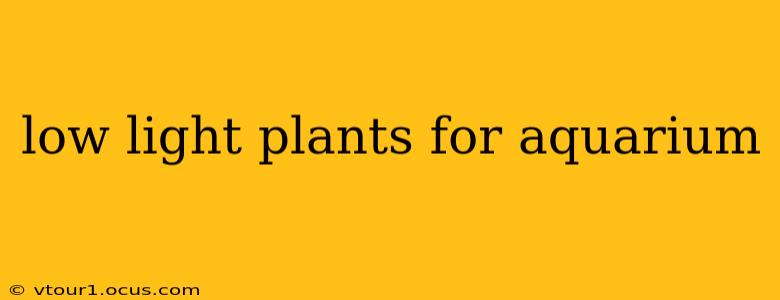Creating a vibrant and healthy aquarium doesn't always require high-intensity lighting. Many beautiful and resilient plant species thrive even in low-light conditions, making them perfect for beginners or those with less demanding setups. This guide explores a selection of these low-light champions, addressing common questions about their care and helping you cultivate a thriving underwater ecosystem.
What are the best low-light aquarium plants?
Several hardy plant species flourish under low-light conditions. Some popular choices include:
-
Java Moss (Taxiphyllum barbieri): This incredibly versatile plant is a staple in low-light aquariums. It attaches easily to rocks, wood, or even the substrate, forming lush, green carpets or cascading waterfalls. Java moss is extremely forgiving and tolerates a wide range of water parameters.
-
Anubias Nana: Another low-light superstar, Anubias Nana boasts attractive, dark green leaves and a slow-growing nature, minimizing maintenance. It's crucial not to bury the rhizome (root structure) in the substrate, as this can lead to rotting. Attach it to hardscape instead.
-
Amazon Sword (Echinodorus amazonicus): While it appreciates brighter light for optimal growth, the Amazon Sword can adapt to low-light conditions, albeit at a slower growth rate. It provides a majestic, central focal point for your aquarium.
-
Java Fern (Microsorum pteropus): Similar to Anubias, Java Fern is incredibly hardy and low-maintenance. It prefers to be attached to driftwood or rocks rather than planted in the substrate.
-
Cryptcorynes (various species): Cryptcorynes offer a variety of shapes, sizes, and colors, making them a versatile addition to any low-light aquarium. They are relatively slow-growing and tolerant of fluctuating water parameters.
How much light do low-light aquarium plants need?
The term "low light" is relative. Generally, low-light plants can survive with only 4-6 hours of indirect sunlight per day, or equivalent artificial light. Avoid direct, intense sunlight which can cause algae blooms. A low-wattage fluorescent or LED light is usually sufficient. You’ll notice slower growth compared to higher light setups, but the plants will still remain healthy.
What are some easy low-light aquarium plants for beginners?
For beginners, Java Moss and Anubias Nana are excellent choices. Their resilience and ease of care make them ideal for those new to aquascaping. They tolerate a range of conditions and are unlikely to be affected by minor mistakes in water parameters.
Do low-light aquarium plants need CO2 injection?
While CO2 injection can benefit all aquarium plants, including low-light species, it is not strictly necessary. Low-light plants have adapted to survive in environments with lower levels of CO2. However, adding CO2 can promote faster growth and fuller foliage, if desired.
How often should I fertilize low-light aquarium plants?
Even low-light plants benefit from occasional fertilization, particularly with micronutrients. Use a liquid fertilizer specifically designed for aquariums, following the manufacturer’s instructions carefully. Over-fertilizing can lead to algae problems, so start with a low dose and increase gradually as needed.
Can I use low light plants in a heavily planted tank?
While low-light plants will survive, they won't thrive in a heavily planted tank if the lighting isn't sufficient for all the plants. Heavily planted tanks usually require more intense lighting to support the increased biological activity and oxygen demand. Consider your lighting capabilities before selecting your plant mix.
What are the signs of a low-light plant struggling?
Signs of struggling low-light plants include slow or stunted growth, pale or yellowing leaves, and leaf loss. If you notice these symptoms, assess your lighting, fertilization regimen, and water parameters to determine the cause.
By carefully choosing appropriate plants and understanding their specific needs, you can create a beautiful and thriving low-light aquarium that brings a touch of underwater nature into your home. Remember that patience is key, and with a little care, your aquatic garden will flourish.
